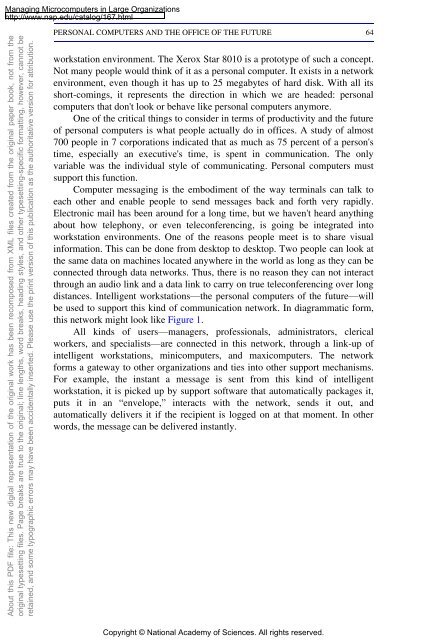Managing Computers in Large Organizations
Create successful ePaper yourself
Turn your PDF publications into a flip-book with our unique Google optimized e-Paper software.
<strong>Manag<strong>in</strong>g</strong> Microcomputers <strong>in</strong> <strong>Large</strong> <strong>Organizations</strong><br />
http://www.nap.edu/catalog/167.html<br />
About this PDF file: This new digital representation of the orig<strong>in</strong>al work has been recomposed from XML files created from the orig<strong>in</strong>al paper book, not from the<br />
orig<strong>in</strong>al typesett<strong>in</strong>g files. Page breaks are true to the orig<strong>in</strong>al; l<strong>in</strong>e lengths, word breaks, head<strong>in</strong>g styles, and other typesett<strong>in</strong>g-specific formatt<strong>in</strong>g, however, cannot be<br />
reta<strong>in</strong>ed, and some typographic errors may have been accidentally <strong>in</strong>serted. Please use the pr<strong>in</strong>t version of this publication as the authoritative version for attribution.<br />
PERSONAL COMPUTERS AND THE OFFICE OF THE FUTURE 64<br />
workstation environment. The Xerox Star 8010 is a prototype of such a concept.<br />
Not many people would th<strong>in</strong>k of it as a personal computer. It exists <strong>in</strong> a network<br />
environment, even though it has up to 25 megabytes of hard disk. With all its<br />
short-com<strong>in</strong>gs, it represents the direction <strong>in</strong> which we are headed: personal<br />
computers that don't look or behave like personal computers anymore.<br />
One of the critical th<strong>in</strong>gs to consider <strong>in</strong> terms of productivity and the future<br />
of personal computers is what people actually do <strong>in</strong> offices. A study of almost<br />
700 people <strong>in</strong> 7 corporations <strong>in</strong>dicated that as much as 75 percent of a person's<br />
time, especially an executive's time, is spent <strong>in</strong> communication. The only<br />
variable was the <strong>in</strong>dividual style of communicat<strong>in</strong>g. Personal computers must<br />
support this function.<br />
Computer messag<strong>in</strong>g is the embodiment of the way term<strong>in</strong>als can talk to<br />
each other and enable people to send messages back and forth very rapidly.<br />
Electronic mail has been around for a long time, but we haven't heard anyth<strong>in</strong>g<br />
about how telephony, or even teleconferenc<strong>in</strong>g, is go<strong>in</strong>g be <strong>in</strong>tegrated <strong>in</strong>to<br />
workstation environments. One of the reasons people meet is to share visual<br />
<strong>in</strong>formation. This can be done from desktop to desktop. Two people can look at<br />
the same data on mach<strong>in</strong>es located anywhere <strong>in</strong> the world as long as they can be<br />
connected through data networks. Thus, there is no reason they can not <strong>in</strong>teract<br />
through an audio l<strong>in</strong>k and a data l<strong>in</strong>k to carry on true teleconferenc<strong>in</strong>g over long<br />
distances. Intelligent workstations—the personal computers of the future—will<br />
be used to support this k<strong>in</strong>d of communication network. In diagrammatic form,<br />
this network might look like Figure 1.<br />
All k<strong>in</strong>ds of users—managers, professionals, adm<strong>in</strong>istrators, clerical<br />
workers, and specialists—are connected <strong>in</strong> this network, through a l<strong>in</strong>k-up of<br />
<strong>in</strong>telligent workstations, m<strong>in</strong>icomputers, and maxicomputers. The network<br />
forms a gateway to other organizations and ties <strong>in</strong>to other support mechanisms.<br />
For example, the <strong>in</strong>stant a message is sent from this k<strong>in</strong>d of <strong>in</strong>telligent<br />
workstation, it is picked up by support software that automatically packages it,<br />
puts it <strong>in</strong> an “envelope,” <strong>in</strong>teracts with the network, sends it out, and<br />
automatically delivers it if the recipient is logged on at that moment. In other<br />
words, the message can be delivered <strong>in</strong>stantly.<br />
Copyright © National Academy of Sciences. All rights reserved.


















